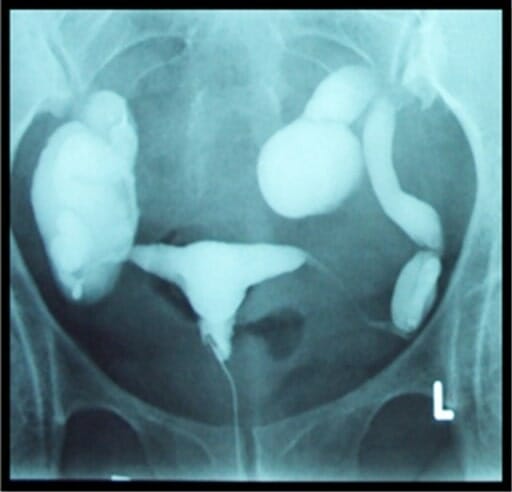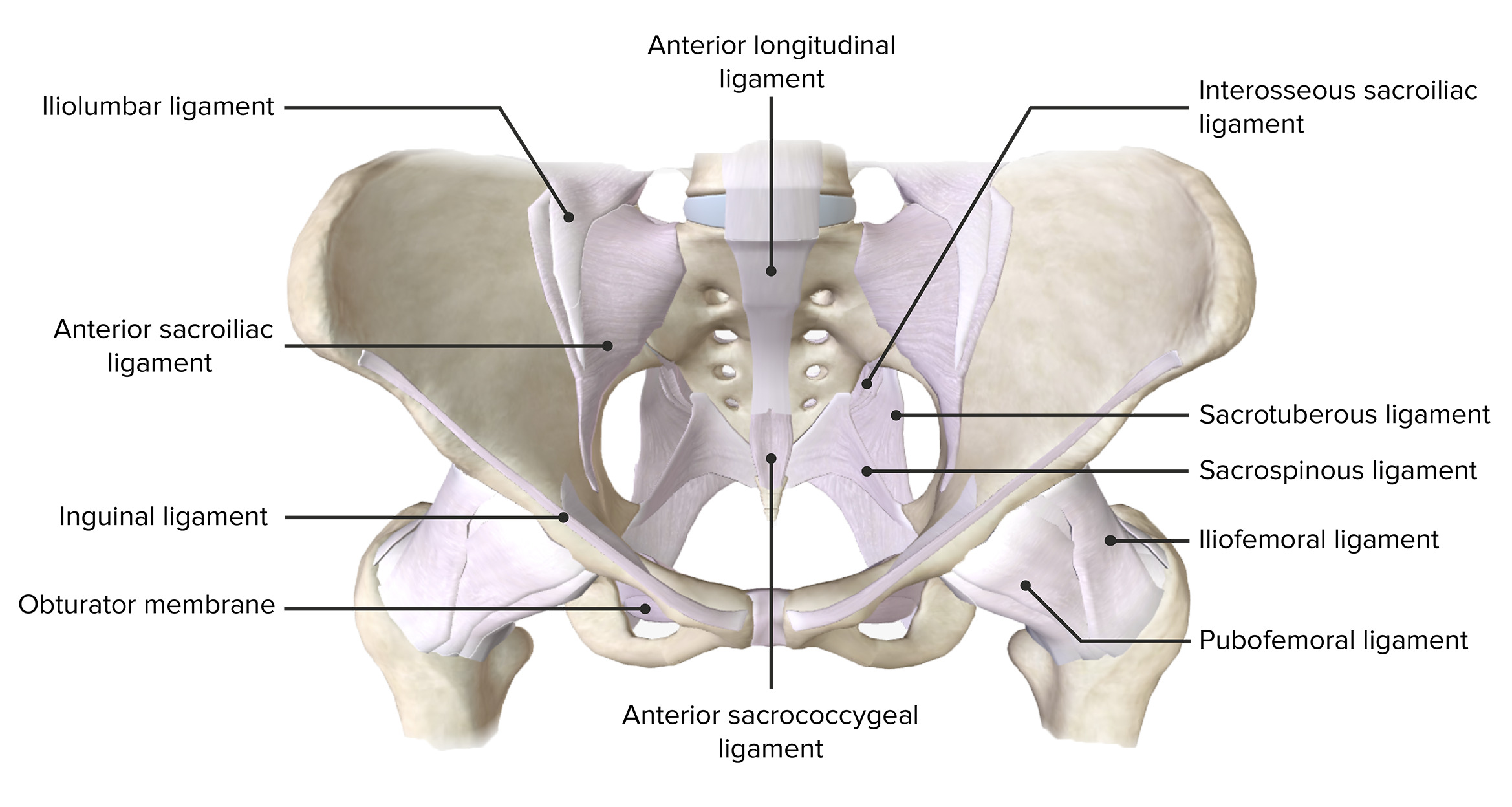Playlist
Show Playlist
Hide Playlist
Female Pelvic Anatomy
-
Slides Female Pelvic Anatomy.pdf
-
Download Lecture Overview
00:01 So before we talk about female pelvic pathology. 00:04 Let's do a quick review of female pelvic anatomy. 00:07 This is a diagram that shows you normal uterine anatomy. 00:11 We can see here the uterus. This is the uterine myometrium and then within it is the endometrial cavity, as we come further down we have the cervical canal and then the vagina. 00:24 Off to the sides of the uterus are the two ovaries which we see here on either side and then over the ovaries are the two fallopian tubes. 00:33 So let's keep this in mind as we look further at ultrasound anatomy. 00:37 So pelvic ultrasound can be performed both transabdominally and transvaginally. 00:42 A transabdominal ultrasound is performed with a full bladder which helps push away the adjacent loops of bowel and provides a better window to help evaluate the pelvis. 00:51 A transvaginal ultrasound provides better details of the endometrium and into the ovaries. 00:55 So a lot of times both are performed together. 00:58 Ultrasound is used as a diagnostic tool in women that are presenting with pelvic symptoms such as vaginal bleeding or lower abdominal or pelvic pain. 01:08 This is usually the first line of imaging used in these patients. 01:11 Routine surveillance and is also used as diagnostic tool in pregnant women. 01:15 So let's take a look at normal ultrasound anatomy. 01:18 So let's keep in mind that diagram as we do this. 01:21 So we have a full bladder here. 01:23 You can see that it's full of fluid and then right here behind it is the uterus. 01:27 So this is a sagittal image of the uterus and you can see here that it's labeled as a sagittal. 01:33 So it's important to look at the labels because it will tell you which direction that you're scanning in. 01:37 So here's the sagittal image of the uterus and then right within it here is endometrium. 01:42 On the right side we have a transverse image of the uterus. 01:45 So the images are always performed both sagittal or long and then transverse or side to side. 01:51 This is again the full urinary bladder and then here we have the uterus. 01:56 So let's take a look at the endometrium. 01:58 Let me outline here the uterus for you again. So this is a transverse image of the uterus and this entire structure here is the uterus. 02:07 If you look here, the echogenic area within the center of this is endometrium. 02:12 The rest of the uterus is the myometrium. 02:15 So a sonohysterogram is the type of ultrasound procedure in which saline is injected into the uterine cavity and it provides a better visualization of the endometrium. 02:24 So usually when a patient comes in with pelvic symptoms. 02:27 A regular ultrasound is performed first and then if we see any abnormalities of the endometrium. 02:32 The patient then goes on to a sonohysterogram to take a a better look at the endometrium. 02:36 So let's evaluate uterine position. 02:39 The uterus can change position in a variety of ways. 02:42 It can be flexed and flexion is the position of the uterine body with respect to the cervix. It can be anteflex or retroflex. 02:50 Version is actually the position of the cervix with respect to the vagina and the uterus can be anteverse or restoverse. 02:58 So those are the two different types of uterine positions both flexion and version. 03:02 A normal endometrium can vary quite a bit. 03:05 So in a premenopausal female the thickness varies based on her cycle and it can be as thick as 18 to 20 mm or it can also be very, very thin down to maybe even 1 or 2 mm and again this varies based on the cycle. 03:17 In an asymptomatic postmenopausal female, the thickness is approximately 4 mm or less. 03:23 If it is any thicker than that then you worry about an endometrial carcinoma because there is no hormonal input to the endometrium in a postmenopausal female. 03:32 The endometrium really does not become any thicker than 4mm or so. 03:36 So let's take a look at what a normal endometrium should look like on this sagittal image. 03:41 So you can see here, this is a transvaginal ultrasound and the way we know that is this little symbol that's right up here. 03:48 That tells us that this is a transvaginal ultrasound. 03:51 This is a sagittal image and you can see the entire uterus, right here. 03:55 And you can see the endometrium right here with the endometrial thickness labeled as approximately 3mm which is normal. 04:03 So these are ultrasound images of the normal ovaries. 04:07 We can see a normal left ovary right here and then we have a normal right ovary on this side. 04:15 The ovaries can also work very quite a bit in appearance. 04:17 They're best seen on a transvaginal exam which again we see here, this is a transvaginal exam with this little symbol here. 04:23 And the ovaries may or may not have follicles especially in a premenopausal female. 04:27 The follicles can get somewhat large especially if there's a dominant follicle which can be at least a couple of centimeter, if not more in size or the ovaries can be very quiescent as we see on the right side with really no significant follicles noted. 04:40 Both are considered normal. 04:41 On a CT scan we can see the uterus and the ovaries. 04:44 So this is an axial CT scan through the pelvis with contrast administration, you can see that the vessels are somewhat highlighted and you can see here the uterus and then we have an example of an ovary here. 04:56 So although we can see the ovaries and the uterus on a pelvic CT scan. 04:59 They're really not well evaluated which is why ultrasound is really used as the first line of imaging for any kind of female pelvic abnormality. 05:07 Pelvic MRIs are also very useful because pelvic anatomy is actually very well seen but MRI is really used more as problem solving tool for the pelvis. When a patient comes in with pelvic symptoms an ultrasound is really what's performed first because it's a very fast way to evaluate the pelvis and it's very accurate, most abnormalities are seen very well on ultrasound. 05:26 However, if there's any questions of what's going on, a pelvic MRI would be a good next step. 05:31 So let's take a quick look at the anatomy of the pelvis. 05:34 So here we have a sagittal image of the pelvis. 05:37 This is the uterus right here and we can see a small portion of the endometrium here which appears bright. 05:44 This is urinary bladder anterior to the uterus and then we have rectum posterior to the uterus. 05:53 Remember that MRI can actually be performed in multiple different plains. 05:57 So we can well evaluate the pelvic organs using MRI. 06:00 So we've looked at some normal pelvic anatomy. 06:02 Just as a review before we go on to pelvic abnormalities. 06:05 I think this will be good basis to move on forward with pathology.
About the Lecture
The lecture Female Pelvic Anatomy by Hetal Verma, MD is from the course Abdominal Radiology.
Included Quiz Questions
A 36-year-old woman presents to the clinic with the complaint of heavy menstrual flow for the past 5 months. She also says that her cycles are more frequent and painful than before. Which diagnostic test would help in identifying her condition?
- Ultrasound
- Xray
- CT scan
- MRI
- Hysteroscopy
Which statement is TRUE regarding uterine anatomy?
- The position of the uterine body can be anteflexed or retroflexed with respect to the cervix.
- Version is the position of the cervix with respect to the ureters.
- The normal endometrial thickness in a premenopausal woman can be up to 40-50 mm.
- The endometrial thickness in a post-menopausal menopausal woman is 4 cm or more.
- The fallopian tubes lie below the level of the ovaries.
Customer reviews
5,0 of 5 stars
| 5 Stars |
|
1 |
| 4 Stars |
|
0 |
| 3 Stars |
|
0 |
| 2 Stars |
|
0 |
| 1 Star |
|
0 |
Very helpful overview of normal anatomy as seen on US, CT, and MRI





